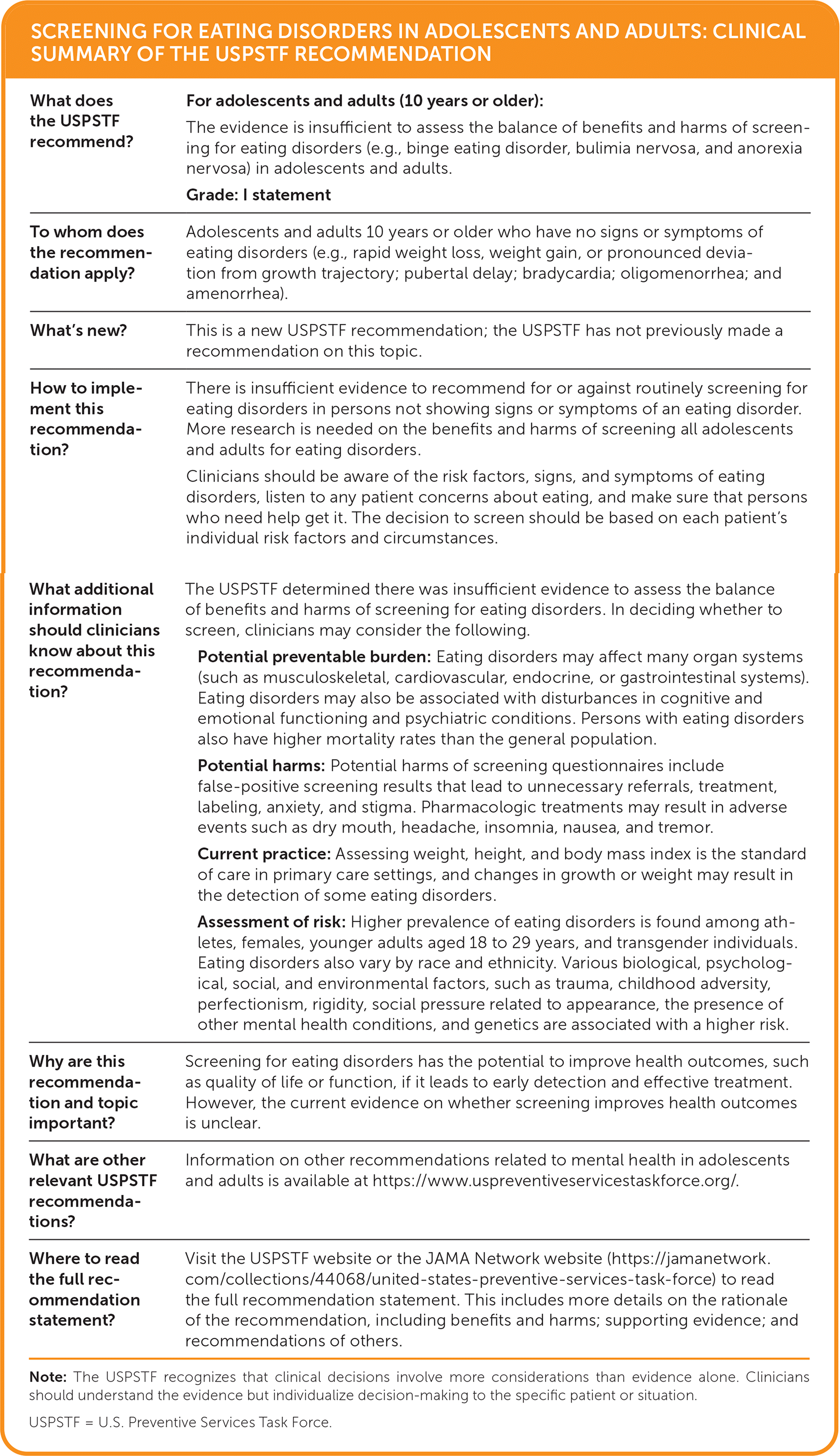
Am Fam Physician. 2023;108(4):online
As published by the USPSTF.

| What does the USPSTF recommend? | For adolescents and adults (10 years or older): The evidence is insufficient to assess the balance of benefits and harms of screening for eating disorders (e.g., binge eating disorder, bulimia nervosa, and anorexia nervosa) in adolescents and adults. Grade: I statement |
| To whom does the recommendation apply? | Adolescents and adults 10 years or older who have no signs or symptoms of eating disorders (e.g., rapid weight loss, weight gain, or pronounced deviation from growth trajectory; pubertal delay; bradycardia; oligomenorrhea; and amenorrhea). |
| What’s new? | This is a new USPSTF recommendation; the USPSTF has not previously made a recommendation on this topic. |
| How to implement this recommendation? | There is insufficient evidence to recommend for or against routinely screening for eating disorders in persons not showing signs or symptoms of an eating disorder. More research is needed on the benefits and harms of screening all adolescents and adults for eating disorders. Clinicians should be aware of the risk factors, signs, and symptoms of eating disorders, listen to any patient concerns about eating, and make sure that persons who need help get it. The decision to screen should be based on each patient’s individual risk factors and circumstances. |
| What additional information should clinicians know about this recommendation? | The USPSTF determined there was insufficient evidence to assess the balance of benefits and harms of screening for eating disorders. In deciding whether to screen, clinicians may consider the following. Potential preventable burden: Eating disorders may affect many organ systems (such as musculoskeletal, cardiovascular, endocrine, or gastrointestinal systems). Eating disorders may also be associated with disturbances in cognitive and emotional functioning and psychiatric conditions. Persons with eating disorders also have higher mortality rates than the general population. Potential harms: Potential harms of screening questionnaires include false-positive screening results that lead to unnecessary referrals, treatment, labeling, anxiety, and stigma. Pharmacologic treatments may result in adverse events such as dry mouth, headache, insomnia, nausea, and tremor. Current practice: Assessing weight, height, and body mass index is the standard of care in primary care settings, and changes in growth or weight may result in the detection of some eating disorders. Assessment of risk: Higher prevalence of eating disorders is found among athletes, females, younger adults aged 18 to 29 years, and transgender individuals. Eating disorders also vary by race and ethnicity. Various biological, psychological, social, and environmental factors, such as trauma, childhood adversity, perfectionism, rigidity, social pressure related to appearance, the presence of other mental health conditions, and genetics are associated with a higher risk. |
| Why are this recommendation and topic important? | Screening for eating disorders has the potential to improve health outcomes, such as quality of life or function, if it leads to early detection and effective treatment. However, the current evidence on whether screening improves health outcomes is unclear. |
| What are other relevant USPSTF recommendations? | Information on other recommendations related to mental health in adolescents and adults is available at https://www.uspreventiveservicestaskforce.org/. |
| Where to read the full recommendation statement? | Visit the USPSTF website or the JAMA Network website (https://jamanetwork.com/collections/44068/united-states-preventive-services-task-force) to read the full recommendation statement. This includes more details on the rationale of the recommendation, including benefits and harms; supporting evidence; and recommendations of others. |
The full recommendation statement is available at https://www.uspreventiveservicestaskforce.org/uspstf/recommendation/screening-eating-disorders-adolescents-adults#fullrecommendationstart.
The USPSTF recommendations are independent of the U.S. government. They do not represent the views of the Agency for Healthcare Research and Quality, the U.S. Department of Health and Human Services, or the U.S. Public Health Service.
